
by Bruce Wells | May 27, 2023 | Petroleum Art
Thousands of glass-negative images document the earliest scenes of U.S. petroleum industry.
Soon after the first American oil well in August 1859 launched the U.S. petroleum industry in remote northwestern Pennsylvania, a young immigrant from England began documenting oilfield life among the wooden derricks and engine houses. Photographer John Mather created thousands of historic images and became known as the “Oil Creek Artist.”
The newcomer to America set up his first studio in Titusville, Pennsylvania, in the fall of 1860. The growing town was an ideal location for documenting the people and evolving drilling technologies of petroleum exploration and production.
John A. Mather (1829-1915) became the premier photographer of the nation’s young oil and natural gas industry. He would amass more than 20,000 glass plate negatives.
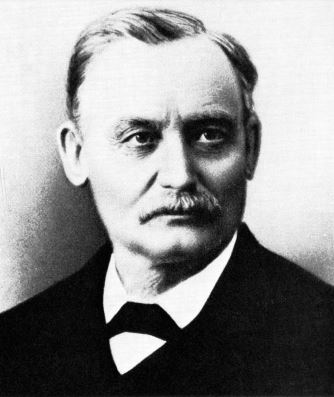
Oilfield photographer John Aked Mather, probably a self-portrait circa 1900.
What Civil War photographers Matthew Brady and James Gardner documented on battlefields, Mather accomplished in Pennsylvania’s oilfields. He photographed the iconic image of Edwin L. Drake, standing at the original site soon after the first oil well fire in October 1859.

Like Brady, Mather had abandoned one-of-kind daguerreotypes and ambrotypes in favor of wet plate negatives using collodion — a flammable, syrupy mixture also called “nitrocellulose.” With one glass plate, many paper copies of an image could be printed and sold.
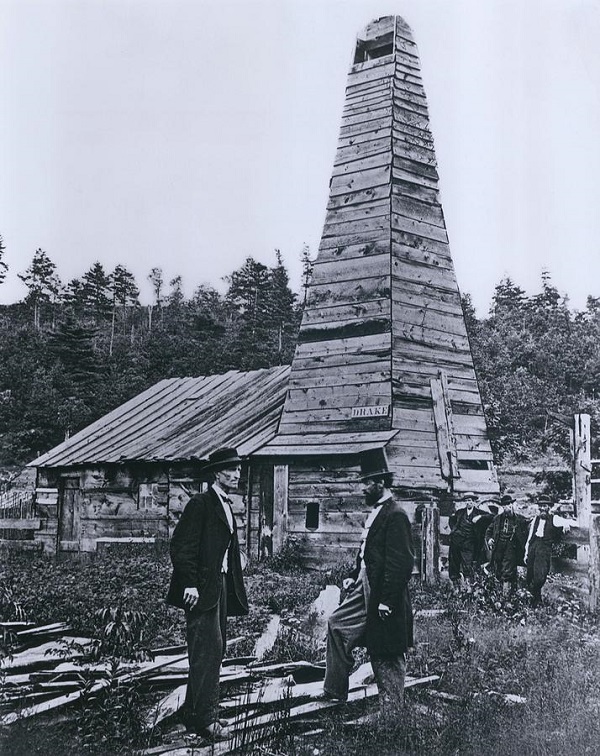
Iconic but often misidentified photo by John A. Mather shows Edwin L. Drake (at right) with a friend standing at the rebuilt derrick and engine house of the first U.S. commercial oil well of August 1859. An October fire destroyed the originals. Photo courtesy Drake Well Museum.
However, unlike most of the era’s studio photographers, Mather transported his camera and chemicals into the industrial chaos of early Pennsylvania oilfields, where he became known as the “Oil Creek Artist.” Like most of people in the new oil region, Mather was susceptible to “oil fever;” he hoped to drill some successful wells himself.
Having narrowly missed the opportunity for a one-sixteenth share of the Sherman Well, which would be “best single strike of the year,” Mather and three associates invested in wells near Pithole Creek. He proved to be better at using a camera.
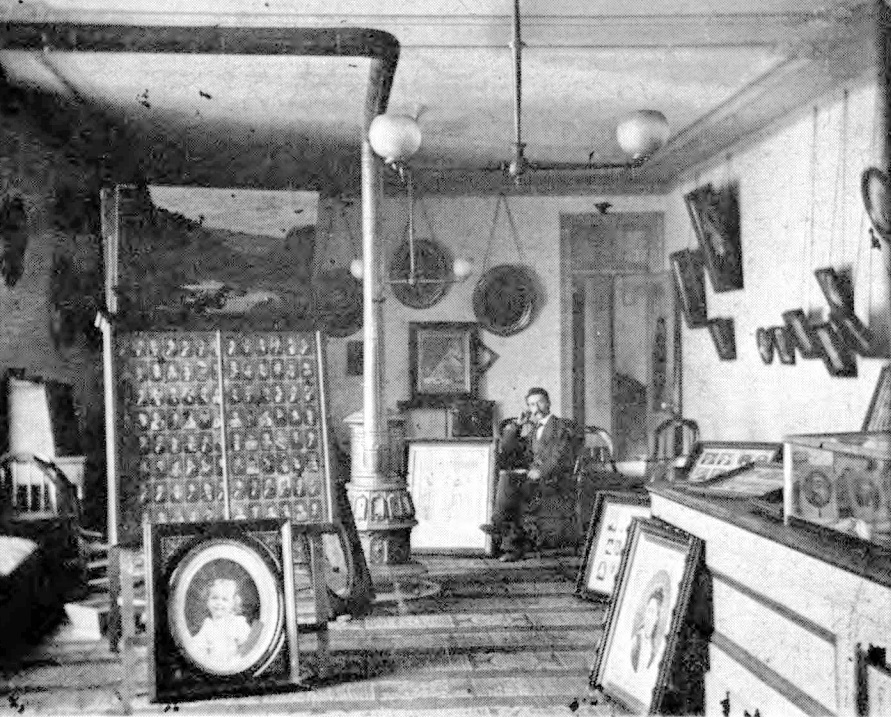
John Mather photographs courtesy Western Pennsylvania Historical Magazine and Drake Well Museum, Titusville. Above, the interior of his Titusville studio, circa 1865.
Mather’s investment in exploratory wells at Pithole Creek did not lead to commercial quantities of oil. He tried again on the Holmden Farm off West Pithole Creek. His unsuccessful effort was among the last wells to be drilled at the infamous oil boom town of Pithole.

Many tried, but few in the increasingly crowded oil region would rival the wealth of the celebrated “Coal Oil Johnny.” Years later, Mather acknowledged that excitement of the drilling for “black gold” was so great that he “forsook photography for the oil business.”
Meanwhile, the young U.S. petroleum industry would learn some hard lessons, including disasters like the fatal Rouseville oil well fire of 1861.
Returning to the oilfields with his camera, Mather’s rolling darkroom and floating studio traveled up and down Oil Creek. His more than 16,000 glass negatives were later described by the trade magazine Petroleum Age as “so perfect in finish it stands the test of time.”
Flood and Fire at Oil Creek
On Sunday morning June 5, 1892, and after weeks of rain, Oil Creek’s overflowing Spartansburg Dam failed at about 2:30 a.m. A wall of water and debris swelled towards Titusville and its oil works, seven miles downstream.
“On rushed the mad waters, tearing away bridge after bridge, carrying away horses, homes and people,” one newspaper reported about the flood’s devastation. Then fire erupted from ruptured benzine and oil storage tanks.
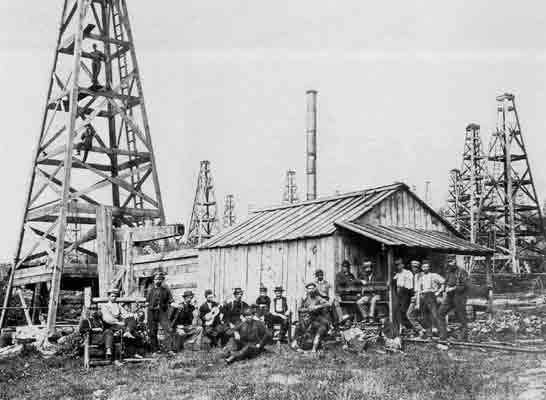
Oilfield workers pose on and among their oil derricks and engine houses in this 1864 John Mather photo from the Drake Well Museum collection in Titusville, Pennsylvania.
Newspapers all over America carried stories of the disaster. In Montana, the Helena Independent headlines included: “Waters of an Overflowing Creek Become a Rushing Mass of Flames” and victims being, “Spared by the Deluge Only to Become the Prey of the Fire.”
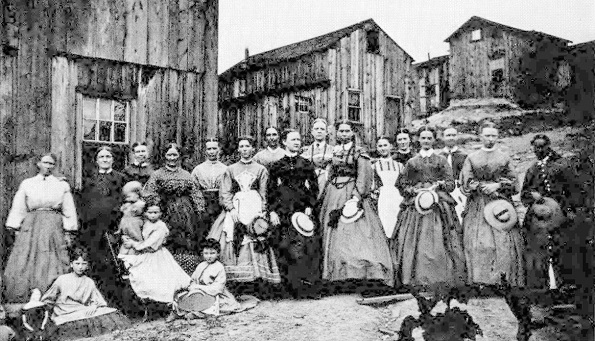
John Mather’s photographs documented family life in remote early oil boom towns. He also briefly caught “oil fever” and unsuccessfully invested in a few wells in booming Pithole Creek field.
The Brooklyn Daily Eagle added: “The Waters Subside and The Flames Die Away, Revealing the Full Extent of the Calamity.” Oil City and Titusville were “Nearly Wiped From Off the Earth.” Mather’s studio flooded to a depth of five feet, destroying expensive equipment and most of his life’s work of prints from glass plate negatives.
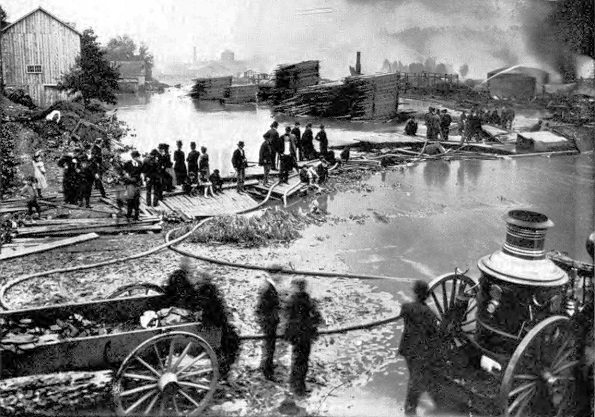
Pennsylvania oil towns were “Nearly Wiped From Off the Earth” by an 1892 fire and flood that destroyed thousands of Mather’s prints and glass plates. Photo from Drake Well Museum collection.
As the fires and flood continued, Mather set up his camera and photographed the disaster in progress with his bulky equipment, which already was being rendered obsolete by new imaging technologies.

Just a few years before the Titusville flood, George Eastman of Rochester, New York, introduced celluloid roll film and created an entirely new market: amateur snapshot photography. Expertise in preparing fragile glass plates and dangerous chemicals were no longer required. Instead, Kodak offered, “You Press the Button, We Do the Rest.”
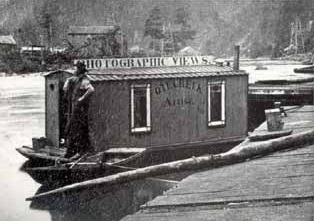
John Mather often used a floating darkroom to capture his historic images along Oil Creek.
As oil booms moved to discoveries in other states, including the massive 1901 “Lucas Gusher” in Texas, Mather worked little in his later years. His financial circumstances diminished with age and illness.
The Artist of Oil Creek died poor and without fanfare on August 23, 1915, in Titusville. His death certificate reported the cause as cerebral hemorrhage, “complicated by suppression of urine.”

An 1865 John Mather photo of derricks at Pioneer Run — Oil Creek, Pennsylvania.
To preserve John A. Mather’s petroleum industry legacy, the Drake Well Memorial Association would purchase 3,274 surviving glass negatives for about 30 cents each. Today, the Drake Well Museum and surrounding park allow visitors to see rare artifacts and a visual record of the early U.S. oil and natural industry. Visit it and other Pennsylvania petroleum museums.
More Mather Resources
“Virtually unknown, certainly unheralded, and completely unappreciated — in these few words is a description of John Aked Mather, pioneer photographer, whose skill, devotion, and energy endowed the petroleum industry with one of the finest pictorial records of growth and development of any early all-American industry,” proclaimed Ernest C. Miller and T.K. Stratton in their January 1972 article, “Oildon’s Photographic Historian,” in The Western Pennsylvania Historical Magazine (Volume 55, Number 1).

“Born in 1829 in Heapford Bury, England, the son of an English paper-mill superintendent, Mather followed his two brothers to America in 1856. His brother Robert was looking to open a paper mill in Tennessee, but John was not ready to settle down, too transfixed by the beauty of the Pennsylvania and Eastern Ohio regions,” explained a NWPaHeritage article by Stephanie David and Brennen French.
The authors of “John A. Mather’s Photographic Studio” added that “Mather was In his obsessive desire to capture the industry in its entirety.”
American Oil & Gas Historical Society (supporting members only) original Research Folder.
_______________________________
The American Oil & Gas Historical Society (AOGHS) preserves U.S. petroleum history. Become an AOGHS annual supporting member and help maintain this energy education website and expand historical research. For more information, contact bawells@aoghs.org. © 2023 Bruce A. Wells.
Citation Information – Article Title: “Oilfield Photographer John Mather.” Authors: B.A. Wells and K.L. Wells. Website Name: American Oil & Gas Historical Society. URL: https://aoghs.org/petroleum-art/oilfield-photographer-john-mather. Last Updated: May 27, 2023. Original Published Date: March 11, 2005.
by Bruce Wells | Apr 1, 2022 | Petroleum Art
A brief look at some fiction books, oil patch memories, and biographies from AOGHS website visitors.
Part of the American Oil & Gas Historical Society’s energy education mission is updating the AOGHS website’s links to oil history books and many other media resources relating to petroleum history. Classic historical texts available online include Paul H. Giddens’s 1936 The Birth of the Oil Industry (with introduction by Ida Tarbell). Historic, petroleum-related images by noted painters also are featured in Oilfield Artists.
In addition, some historical society’s website visitors have requested a post that includes their fiction, oil patch research, and personal accounts or biographies.
Supporting the American Oil & Gas Historical Society — Amazon Associates
History Books from Amazon ; Education and Teaching Books
; Education and Teaching Books ; Biographies and Memoirs
; Biographies and Memoirs ; Engineering and Transportation; and Politics and Social Sciences. Amazon purchases benefit the American Oil & Gas Historical Society. As an Amazon Associate, AOGHS earns a commission from qualifying purchases.
; Engineering and Transportation; and Politics and Social Sciences. Amazon purchases benefit the American Oil & Gas Historical Society. As an Amazon Associate, AOGHS earns a commission from qualifying purchases.
“Petrol Thriller” battles U.S. Oil Reserve turned into Water
Gary Kraidman is author of ANAEROBE (A Nick Torno Petro Thriller). According to the author, his eco-terror microbial thriller, which is available as a Kindle Edition, features Nick Torno foiling a plot where “the bad guys” plan to turn America’s oil to water with a novel microbe.
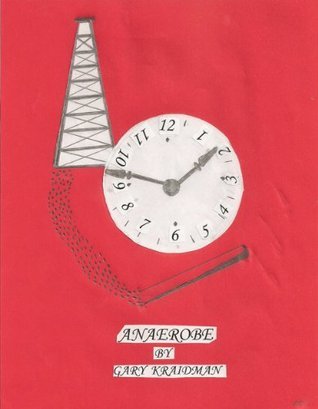
Kraidman’s “Petrol Thriller” is available at Amazon Books and Goodreads, which has described the 253-page edition first published in 2012:
“America’s oil turned to water! Nick Torno, Special Projects Director for the Department of Energy must stop an overseas terror group from contaminating an experimental waste carbon dioxide gas pipeline leading to an deep down oil reserve under the infamous Teapot Dome formation in Wyoming. If the fanatical plotters of eco-terror are successful a novel microbe will enter our underground oil pool and spread rapidly. America’s fossil fuel will cease to exist. The United States of America will remain dependent forever on foreign oil.”
ANAEROBE (A Nick Torno Petro Thriller).
As an Amazon Associate, the American Oil & Gas Historical Society earns a commission from qualifying purchases.
A Wildcatter’s Memories of Oil Hunting
In August 2018, Thomas Cochrane of California published his “wildcatter’s memories,” a fictionalized account of hunting for black gold — searching for oil and natural gas fields.
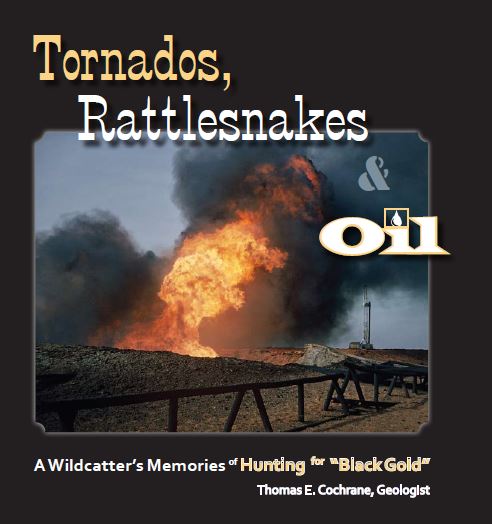
“A fast-paced and lyrical stroll through several decades of searching for oil and gas, punctuated with stories about the greatest gamblers, and insights into petroleum geology,” noted a review by Robert Blackburn, executive director of the Oklahoma Historical Society about Tornadoes, Rattlesnakes & Oil: A Wildcatter’s Memories of Hunting for Black Gold.
As an Amazon Associate, the American Oil & Gas Historical Society earns a commission from qualifying purchases.

Mathew Day, Texas Oil History Sleuth
Available on Amazon Books, researcher and author Matthew M. Day of Lubbock, Texas, has independently published a series e-books and paperbacks exploring little-known histories of the petroleum, railroad, and agricultural industries. His 2021 titles include How to Read Oil History If You’re an Average Joe: or, E. K. Warren and Son (Three Oaks, Michigan) and Oil in Three Western States and The World’s First Petroleum History Coffee-Table Book: or, The Overlooked Legacy of J. P. Morris of Texas: Petro-Cowman, Silver Mine Investor, and Wildlife Preservationist.
Day’s earlier works include Ranches and Rigs: How Three Texas Panhandle Ranches Helped Shape the Oil and Gas Industry’s Formative Years (2020) and Accidental Resurgence?: The Atchison, Topeka, and among his longest titles, Accidental Resurgence?: The Atchison, Topeka, and Santa Fe Railway in West Texas: How Oil, Raw Materials, and Agriculture (Tried To) Save the Railroad Industry on the South Plains at Midcentury.
Drilling Life of Lucien Flournoy of Alice, Texas
The Confederate, a biography of the life and petroleum industry career of Lucien Flournoy (1919-2003), was published in November 2020. According to it author, John W. Flores, the book features Flournoy’s “extraordinary accomplishments centered in Alice, Texas, where he operated Flournoy Drilling Company for more than 50 years — becoming wealthy and a leading citizen of the town about 50 miles west of Corpus Christi.”
Originally from Louisiana, Flournoy studied petroleum engineering at Louisiana State University in Baton Rouge. The future Alice mayor would become a liberal Democratic benefactor, generously donating to Texas A&M University-Kingsville, Texas A&M-Corpus Christi, Driscoll Children’s Hospital, and the Boy Scouts of America, among others.
“In 1946, Flournoy invested about $1,200 in building a drilling rig based on his own designs,” noted The Confederate author John W. Flores. Fifty years later, Flournoy Drilling Company would be sold to a Houston-based company for $50 million. Flournoy’s wife Maxine is also an important part of the story, Flores adds. She was a skilled WASP test pilot during World War II, receiving a Congressional Gold Medal for her service in the Army Air Corps.
Flores first met the Flournoys in 1997 after visiting to write about the businessman’s life for an article in the Alice Echo-New Journal. By May 2001, after Flournoy had hired him to write the biography, the author moved to Texas from Albuquerque, New Mexico. Flores is a journalist and author in the mountains of New Mexico with two books previously published. The Confederate is available via Amazon books; as an Amazon Associate, the American Oil & Gas historical Society earns a commission from qualifying purchases.
History of Michigan Natural Resources Trust Fund
In 1976, Michigan became the first state in the nation to earmark state revenue generated through mineral, including oil and gas, activity for acquisition and improvement of environmentally sensitive and/or public recreation lands. The Michigan Natural Resources Trust Fund (MNRTF) was created by the Kammer Recreational Land Trust Fund Act, signed by Governor William G. Milliken on July 23, 1976.
Through 2010, the Fund has awarded 1,601 MNRTF project grants either active or closed (completed) in each of Michigan’s 83 counties totaling more than $816.6 million.
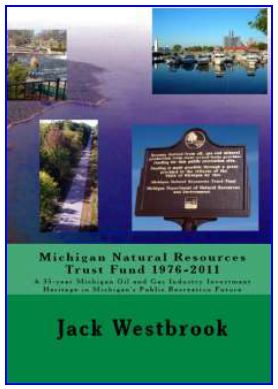
Jack R. Westbrook of Mt. Pleasant has covered the Michigan Natural Resources Trust Fund “from embryo to adulthood.”
From the tip of the Keweenaw Peninsula to a harbor park in downtown Detroit, more than 1,600 public recreation facilities from rail trails to parks to fishing piers statewide have benefited from the Michigan Natural Resources Trust Fund, born of a unique alliance of government, environmental groups and the Michigan oil and gas industry in the mid-1970s serving as a solution to a seeming impasse.
Michigan has produced over 1.25 billion barrels of oil and more than seven trillion feet of natural gas since the discovery of the Saginaw Field in August, 1925. This history has been brought to life by retired Michigan Oil & Gas News magazine Managing Editor Jack R. Westbrook, who covered the Michigan Natural Resources Trust Fund “from embryo to adulthood.”
In his Michigan Natural Resources Trust Fund 1976-2011 a 35 year Michigan investment heritage in Michigan’s public recreation future), Westbrook takes the reader on a tour of the places to play in Michigan’s great outdoors made possible by this historic Fund, listing the projects in each county with general, and oil and gas, histories of their county home venues. The 222 page soft-cover book, Michigan Natural Resources Trust Fund 1976-2011, published by Jack R. Westbrook. Contact him at (989) 773-5741.
As an Amazon Associate, the American Oil & Gas Historical Society earns a commission from qualifying purchases.
Business History of Modern Oil Industry
Written by a scientist, Fueling America: An Insider’s Journey proclaims: “Fossil fuel was the life blood of the industrial revolution. Initially, coal was king as it fueled steam engines that revolutionized agriculture, manufacturing and the railroads.” Oklahoma geophysicist Jack Kerfoot explains why oil surpassed coal in the 1900s and with development of the internal combustion engine, revolutionized transportation.

After spending over 20 years working in the energy industry overseas, Kerfoot in 2018 published Fueling America, which in 244 pages discusses, “our global energy conundrum of finding reliable, sustainable, reliable energy that won’t harm our environment.”
Originally from Tulsa, Kerfoot received a bachelor of science degree in geophysics from the University of Oklahoma. He spent more than four decades in the energy industry, including working for multi-national companies Mobil and Conoco, and independents like Forest Oil, Apache, and Murphy Oil. He today operates a consulting company, J.L. Kerfoot Energy Services, LLC.
Amazon purchases benefit the American Oil & Gas Historical Society. As an Amazon Associate, AOGHS earns a commission from qualifying purchases.
_______________________________________________
The American Oil & Gas Historical Society preserves U.S. petroleum history. Become an AOGHS annual supporting member and help maintain this energy education website and expand historical research. For more information, contact bawells@aoghs.org. © 2022 Bruce A. Wells.
















